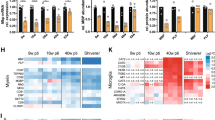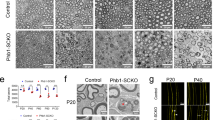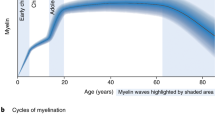Abstract
MYELIN is the most stable membrane known and the fact that it contains ten times as much long chain sphingolipid as any other known membrane structure has led to the suggestion that the long chain fatty acids (> 18 carbon atoms) in these sphingolipids are concerned in the stability of myelin1,2. The finding3,4 of a myelin deficient mouse mutant whose galactolipids and sphingomyelin lack long chain fatty acids led us to investigate whether the elaboration of long chain sphingolipid molecules is a key step in myelin formation. The comparison of histological and biochemical events related to myelination in normal and myelin deficient mutant mice supports the hypothesis that in the events leading to adult myelin, the appearance of fatty acids with 24 carbon atoms follows the appearance of cerebrosides and sulphatides in myelin.
This is a preview of subscription content, access via your institution
Access options
Subscribe to this journal
Receive 51 print issues and online access
$199.00 per year
only $3.90 per issue
Buy this article
- Purchase on Springer Link
- Instant access to full article PDF
Prices may be subject to local taxes which are calculated during checkout
Similar content being viewed by others
References
Vandenheuvel, F. A., J. Amer. Oil Chem. Soc., 40, 455 (1963).
O'Brien, J. S., Science, 147, 1099 (1965).
Baumann, N. A., Jacque, C. M., Pollet, S. A., and Harpin, M. L., Europ. J. Biochem., 4, 340 (1968).
Jacque, C. M., Harpin, M. L., and Baumann, N. A., Europ. J. Biochem., 11, 218 (1969).
Farkas, E., Zand, J. P., Nussbaum, J. L., and Mandel, P., Colloque sur les Mutants Pathologiques. Leur Intérêt pour la Recherche Biomédicale (CNRS, Paris, in the press).
Sidman, R. L., Dickie, M. M., and Appel, S. H., Science, 144, 309 (1964).
Berger, B., Colloque sur les Mutants Pathologiques. Leur Intérêt pour la Recherche Biomédicale (CNRS, Paris, in the press).
Kishimoto, Y., Agranoff, B. W., Radin, N. S., and Burton, R. M., J. Neurochem., 16, 397 (1969).
Davison, A. N., and Gregson, N. A., Biochem. J., 98, 915 (1966).
Moser, H. W., and Karnovsky, M. L., J. Biol. Chem., 234, 1990 (1959).
Maker, H. S., and Hauser, G., J. Neurochem., 14, 457 (1966).
Folch-Pi, J., in Biochemistry of the Developing Nervous System (edit. by Waelsch, H.), 121 (Academic Press, New York, 1955).
Nussbaum, J. L., Neskovic, N., and Mandel, P., J. Neurochem., 16, 927 (1969).
Norton, W. T., Poduslo, S. E., and Suzuki, K., Abst. First Intern. Cong. Neurochem., Strasbourg, 1967, 161.
Eng, L. F., and Noble, E. P., Lipids, 3, 157 (1968).
Banik, N. L., and Davison, A. N., Biochem. J., 115, 1051 (1969).
De Robertis, E., and Gerschenfeld, H. M., J. Biophys. Biochem. Cytol., 4, 651 (1958).
Benson, A. A., J. Amer. Oil Chem. Soc., 43, 265 (1966).
Author information
Authors and Affiliations
Rights and permissions
About this article
Cite this article
BAUMANN, N., HARPIN, M. & BOURRÉ, J. Long Chain Fatty Acid Formation: Key Step in Myelination studied in Mutant Mice. Nature 227, 960–961 (1970). https://doi.org/10.1038/227960a0
Received:
Revised:
Issue Date:
DOI: https://doi.org/10.1038/227960a0
This article is cited by
-
Effects of feeding Lunaria oil rich in nervonic and erucic acids on the fatty acid compositions of sphingomyelins from erythrocytes, liver, and brain of the quaking mouse mutant
Lipids (1998)
-
A new mutant strain of syrian hamster with myelin deficiency
Acta Neuropathologica (1985)
-
H-2 haplotypes, genes, and antigens: Second listing
Immunogenetics (1982)
-
Hyperplasia of oligodendrocytes in quaking mice
Anatomy and Embryology (1975)
Comments
By submitting a comment you agree to abide by our Terms and Community Guidelines. If you find something abusive or that does not comply with our terms or guidelines please flag it as inappropriate.



